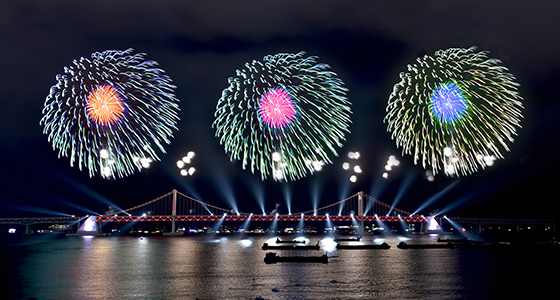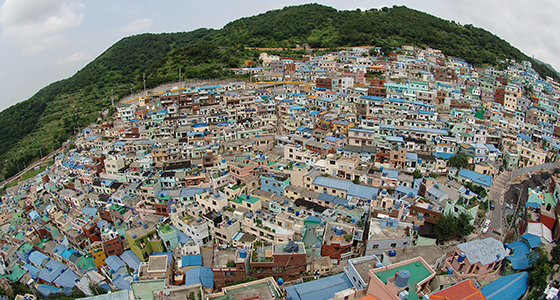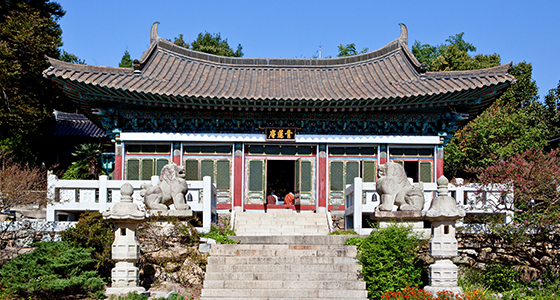

Fantastic City BUSAN
Busan Metropolitan City, where Pusan National University is located, is a bustling city of approximately 3.5 million residents.
It is the second-largest city in Korea. Located on the southeastern tip of the Korean peninsula, Busan is one of the world’s top super ports. Its natural environment is a perfect example of harmony between mountains, rivers and sea, and features a coastline of superb beaches, such as Haeundae and Gwangan, majestic mountains, and Asia’s most sought-after hot springs. Natural endowments and a rich history have resulted in Busan’s increasing reputation as a world-class city for tourism and culture. It has become a leader in the global film industry by hosting the annual Busan International Film Festival (BIFF). Busan is considered ‘dynamic’ due to its special characteristics: the beauty of nature mixed with traditional and modern elegance, personified by open-mindedness and progressiveness of its citizens.
Busan Tourist Attractions
-

Haeundae Beach
The Haeundae area in Busan is famous both in Korea and abroad. Not only is it known for being Korea’s most popular summer vacation spot, but it also attracts large numbers of visitors even during the spring, autumn, and winter due to its variety of festivals and events, such as BIFF, the International Yachting Regatta and the Haeundae Sunrise Festival. These events help keep Haeundae busy as a popular tourist site year-round.
-

Busan Fireworks Festival
Busan Fireworks Festival takes place every October along Gwangan Beach. The festival’s diverse programs of cultural events, high-tech laser light shows, and myriad of unique and colorful fireworks make this one of the area’s most popular events, drawing crowds of over one million visitors each year. Although most people flock to the beach for a closer view of the festivities, nearby Hwangnyeong Mountain also offers a great view of the show.
-

Nurimaru
The name Nurimaru APEC House was created by combining the Korean words for ‘world’ (nuri) and ‘summit’ (maru), and “APEC House,” to reflect its usage as a conference hall for the Asia-Pacific Economic Cooperation (APEC) summit in 2005. The area around the facilities offers a spectacular ocean view.
-

BIFF
The Busan International Film Festival (BIFF) is the largest, oldest, and most prestigious film festival in Northeast Asia. Beginning in 1996 as the first international film festival in Korea, it is now a major global event held annually and features the best in Asian and world cinema.
-

Gamcheon Culture Villiage
Gamcheon Culture Village is a collection of multi-colored houses built after the Korean War in staircase-fashion on the slope of a coastal mountain near the southern tip of the city, earning it the nickname the “Machu Picchu of Busan.” The many alleys cutting through this community are vibrantly decorated with murals and sculptures created by the residents.
-

BEXCO
BEXCO is a large, eight-floor international exhibition/convention center. It offers spacious, multi-purpose exhibition halls as large as three football fields combined, as well as outdoor exhibition space. Equipped with the most advanced equipment, BEXCO is ideal for holding international exhibitions, meetings, concerts, or sporting events.
-

Beomeo Temple
Beomeo Temple (or Beomeosa) is located at the eastern edge of Geumjeong Mountain, the city’s most famous mountain range. The temple was constructed by one of Korea’s most distinguished monks, Ui Sang, in 678, the 18th year of the reign of King Munmu (r. 661-681) of the Silla Kingdom. It is one of the three most famous temples in the Yeongnam (southeastern) region, along with Haein Temple (Haeinsa) and Tongdo Temple (Tongdosa).
-

Busan Port
Busan Port, which is connected to 500 ports in 100 countries, has become the logistics hub port in Northeast Asia in the 21st century. To accommodate the rapidly increasing container traffic in the region, Busan Metro City continues to expand port facilities and distribution systems, while accelerating the development of a state-of-the-art New Port located in the southwestern area of the city.
[source] 'KOREA TOURISM ORGANIZATION' Website
